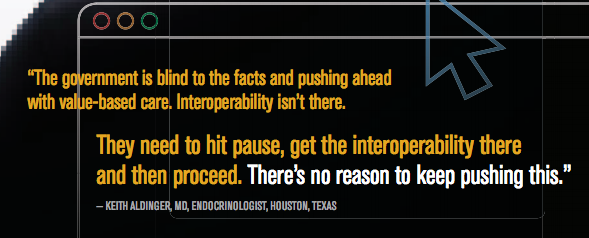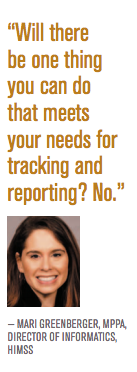Article
How to find the data you need for value-based care reporting
Author(s):
Searching for answers as the industry moves away from fee-for-service
The growing emphasis on value-based care means doctors need detailed patient data for reporting purposes. However, physicians often lack the ability to obtain it. In some cases, the technology exists but practices can’t afford it, while in others, the lack of interoperability among electronic health records (EHR) prevents physicians from accessing the data they need to report treatment and outcomes.
The data doctors need are trapped in various systems across the healthcare landscape as patients move from provider to provider. Tracking down what care each patient has received and getting that data into the primary care physician’s system is a labor-intensive process that takes time and focus away from patient care.
HOT TOPIC: How to report quality data through an ACO
“The hardest thing is the redundancy,” says Nick Beechnau, DO, a primary care physician in Ravenna, Michigan. “Once you get the information from someplace else, you often have to hand input it into your system. For a lot of things like colonoscopies or pap smears, even if it’s in your electronic health record, you have to report it separately to payers to get full reimbursement.”
About 50% of his payers require some type of data to get reimbursement, and the information they want is always changing. “We absolutely expect more payers to continue to want more data for reimbursement,” he adds.
The biggest value-based care program and driver of data collection is the Medicare Access and CHIP Reauthorization Act (MACRA). Physicians with more than $90,000 in Medicare Part B charges or more than 200 Part B beneficiaries must participate in either the Merit-based Incentive Payment System (MIPS) or as an Advanced Alternative Payment Model.
There are 271 quality measures under MIPS, and doctors must choose six to report. Private payer value-based models vary widely, but like MACRA, typically require the collection and reporting of data.

But even when physicians can get the information they need, it’s often in a format that is unusable or takes a lot of time to dissect, says Keith Aldinger, MD, a Houston-based endocrinologist. After a patient’s two-day hospital stay for chest pain, Aldinger requested the patient’s data. “They sent me 75 pages of digital dysentery,” he says of the report generated by the hospital’s EHR system. “There were redundant pages listing every vital sign. It takes time to go through it and it didn’t have what I needed.”
Naresh Rao, DO, a primary care physician and sports medicine doctor in New York City, is participating in value-based contracts and has encountered problems with how data gets attributed. “Patients coming in purely for sports medicine are counted toward my primary care setting,” says Rao. “They list me as their primary care physician even though I only saw them once for a sports-related back issue. If they go out of network or have expensive procedures done, it’s counted against me.”
TRENDING: Are blockchain and AI the keys to opening interoperability in healthcare?
These data issues leave doctors in the lurch, experts say, raising the question of whether they can access the information they need for value-based care reporting.
“The government is blind to the facts and pushing ahead with value-based care,” says Aldinger. “Interoperability isn’t there. They need to hit pause, get the interoperability there and then proceed. There’s no reason to keep pushing this.”
Next: How did we get here?
How did we get here?
Every type of health IT software generates data in its own way. Getting data from one piece of software to another can be time consuming and costly, experts say.
“Healthcare is still primarily a cottage industry of products, patching things together as they can,” says Nancy Pratt, chief operating officer of Airstrip, a company that designs mobile interoperability software for clinicians and health systems, and a 20-year veteran of the industry. “It is easier to transfer a dollar on a mobile banking app or connect two telephones across the globe than it is to transfer medical data; healthcare is clearly behind the curve.”

Robert Tennant, MA, director of health information technology policy for the Medical Group Management Association, says that once the financial industry agreed on information exchange standards, companies started competing on ease of use. ATMs used to only be for the owning bank’s customers, but standards made it possible for anyone to use any machine. He hopes standards in healthcare technology will similarly boost the usability of EHRs to make data sharing and tracking easier. But that goal has thus far proven elusive. “I’m cautiously optimistic that practices will get what they need, but it is not right around the corner,” he adds.
POPULAR ONLINE: 6 reasons it's critical to have an IT emergency plan
Mari Greenberger, MPPA, director of informatics for the Healthcare Information and Management Systems Society (HIMSS), says that she sees progress at the federal level, where interoperability is a hot topic, but progress is slow due to fear of stifling innovation. “I don’t think it will happen [this] year, but hopefully in the next three to five years we’ll see real change,” she says.
Next: Should MIPS be delayed?
Should MIPS be delayed?
Jay Anders, MD, an internist and chief medical officer for Medicomp Systems, a technology company that works on improving EHR usability, says it is too soon to force physicians to do so much data reporting for programs like MIPS.
“From a clinical standpoint, it’s very hard to criticize MIPS’ quality measures in terms of being medically appropriate and aligned with best practices,” says Anders. “However, it’s unrealistic to expect physicians to comply with these new regulations without updated technology. We need to close the current technology gaps before providers are required to link a significant amount of their practice income to the MIPS program.”
IN CASE YOU MISSED IT: Top 10 challenges facing physicians in 2018
A spokesperson for the Centers for Medicare & Medicaid Services (CMS) says that it is committed to working with the Office of the National Coordinator (ONC) on implementation of the interoperability provisions of the 21st Century Cures Act, with the goal of secure exchange of health information for providers and patients. The act defines interoperability and establishes a maximum $1 million-per-violation fine for any developer, exchange or network found to have engaged in data blocking.
When Medical Economics asked CMS whether it is fair to require physicians to participate in programs like MIPS when the technology for data reporting is not ready, CMS referenced its flexibility in reducing the number of practices that must participate and permitting the use of 2014 edition certified EHRs. (For ONC’s view, read our Q&A with National Coordinator Don Rucker, MD, on page 24.)
Next: Tracking down data
Tracking down data
Physicians thus are faced with a difficult dilemma: Interoperability looks to be years away, but the data is required for MIPS and value-based initiatives from private payers now. What are they supposed to do until then?

Experts and doctors say that the only solution is to seek out whatever local resources are available and create workarounds as needed. “Will there be one thing you can do that meets your needs for tracking and reporting? No,” says Greenberger. “If you are a small practice, you might be able to connect to a state health information exchange to fulfill your immunization registry needs, but you probably won’t be able to submit everything you need without being a part of something else.”
FURTHER READING: Is a scribe right for you?
She suggests starting with the state chapters of professional organizations such as the American College of Physicians, American Osteopathic Association or HIMSS to find out what’s available locally and how others are tracking and reporting data.
Physicians should also consult their EHR vendor to see what assistance or add-ons they can provide, says Tennant. There will probably be a fee, so make sure that the information format will be helpful.
Pratt says the best approach for interoperability may be to see which EHR local health systems or larger physician groups are using, and if they offer any technical or financial assistance to install the EHR. “Often, health systems offer to support or partially support ambulatory EHRs to assure interoperability of information for their patients,” she adds.
TRENDING: Uncompensated tasks growing for physicians
Aldinger attempted to set up his own interoperability system with doctors in his area by asking them to sign data-sharing agreements. He persuaded one specialist he works with often to sign on, but most of the others either weren’t on a compatible EHR or weren’t interested.
Next: What you can do
“My only advice is I encourage physicians to write their medical associations and demand they take action or slow down this move to value-based care. If interoperability isn’t here soon, it will just be crazy with all the faxing and calling that will need to be done,” Aldinger says.
Beechnau’s solution was to gain access to the EHRs of two nearby hospitals. He had the advantage of having trained at both hospitals so they knew him. Also, the hospitals were highly competitive with each other. He told them that if he didn’t get a login, he would have to divert his patients to their competitor.
But even having access to their EHRs hasn’t been an ideal solution. The hospitals have changed EHRs, one has a different system for outpatients and the information on patients is in different places in the software depending on the system, so Beechnau must be familiar with multiple software platforms to get everything he needs. And in the end, a front office person still needs to make calls and manually enter faxed information into Beechnau’s system.
MORE: Making population health work in a small practice
While the interoperability that allows doctors to access the data they need for quality reporting leaves much to be desired, Rao points out that EHR technology has come a long way since it was first introduced, and he expects the systems to improve.
“With anything, where there is a problem, there is an opportunity for a business,” says Rao. “Eventually, there will be a system that serves our needs.” In the meantime, his office staff will keep making phone calls and monitoring the fax machine.





